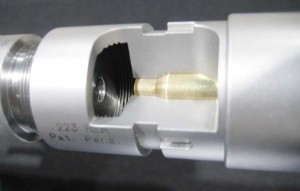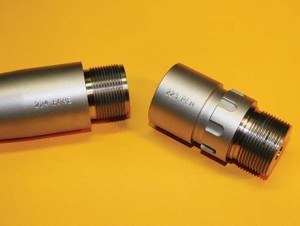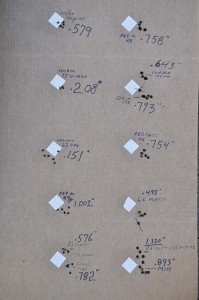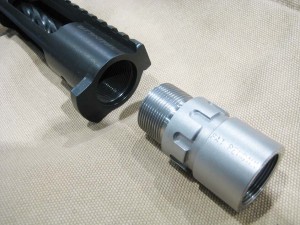by John Markwell | Contributing Editor
Good ideas are a dime a dozen in the world of firearms. Those that perform as advertised sometimes seem few and far between and walking the isles of the SHOT Show leads one to wonder who thinks some of the stuff up. We have been testing what we feel is one of the better ideas applied to rifle technology in quite some time. Production of this new system for attaching barrels to rifles of the bolt-action variety is now in full swing and available to the shooting public from Jamie Dodson of Wolf Precision (WolfPrecision.net). Dodson, in collusion with BAT Machine, is offering his patent-pending chamber and barrel system as an alternative to the traditional method of barreling an action.
Wolf Precision rifles are built one at a time on the proprietary BAT Machine Tactical Action. Dodson’s new barrel/chamber system is actually comprised of two separate parts: the chamber, which is screwed into the BAT action, and the Krieger barrel, which screws into the chamber piece (see the photos). Dodson claims this is the “first major design change to the traditional bolt action rifle in over 100 years.” Whether true or not, the separate chamber/barrel system offers much in the way of convenience for the end user and the gun builder. And, the rifles we tested shot as well as those barreled in the traditional manner.

Here’s a cutaway of the barrel/chamber system from Wolf Precision. It illustrates the internal relationship of the two parts better than I can describe them.
We have had the opportunity to test two of the first batch of Wolf Precision rifles built with this new system; one in .223 Remington and one in .308 Winchester. The 223 had a 1-7.7 twist Krieger barrel and was set in an A.I.C.S. 1.5 stock. The 308 had a 1-11 twist Krieger barrel and was in a McMillan A-Series stock. Both rifles were equipped with Rifle Basics triggers and were fed from detachable box magazines. The 308 rifle was equipped with a suppressor and both the 223 and 308 were topped with Leupold optics. All of the machine work, from building the actions to CNC machining of the chamber piece and threading the corresponding barrel shank, was done by the guys at BAT Machine to their typically tight tolerances.
We have seen more than our share of Wolf Precision rifles in the hands of competitors at the Allegheny Sniper Challenge and personally own a .22-250 Dodson Jamie built for us a few years ago. Our rifle is a tack driver and the rifles we’ve seen on the firing line seemed to be equally accurate. The question is, can this new system, consisting of two parts, equal the accuracy of rifles built with barrels that are chambered in the traditional way?

The precision machining by BAT Machine is obvious in this close up of the chamber piece and threaded shank of the Krieger barrel.
Dodson brought the two rifles pictured down to the mountains so we could shoot them and see for ourselves how they performed. We first shot five shot groups with both the .223 and the .308 at 100 yards using seven factory loads in the .308 and six in the .223. The results, after discounting a few called flyers, are summarized in the chart.
Looking at the target, one will notice that the point of impact for both rifles was similar regardless of the load. Point of aim was the bottom point of the paster for most groups although a couple of pasters had two groups fired at them. The second group’s hold point was the top of the diamond. We would have liked to do a more extensive test from the bench but, like many of our readers, we are still suffering some from the recent ammo crisis and price increases.
We were more interested in how the two Wolf Precision rifles would perform in the field, so Dodson and I loaded the truck and headed for the mountain to shoot some steel at distance. Using Dodson’s 75-gr. Hornady A-Max handload in the .223 rifle and Federal Match with 168-gr. SMKs in the .308, we shot steel from 200 to 600 yards using Dodson’s DOPE. The wind was a bit switchy but we managed to hit steel most of the time and even managed to shoot a few pretty respectable groups with both rifles at 500 yards.

This test target illustrates the accuracy of the new Wolf Precision chamber/barrel system. Groups fired with the 308 are the right column; 223 the left.
The possibilities and advantages that this system offers to the shooter are really only limited by one’s imagination. BAT Machine actions come in different lengths but let’s assume one is interested in shooting only cartridges that will function in a short action. Utilizing different chamber pieces, appropriate barrels and bolt heads, one action can accommodate rounds like the .223, .22-250, .308, etc. No machining is needed to make the changes from one caliber to another. Adhering to appropriate torque specifications is the only technical part of making the change. Should one need to replace a barrel, the chamber does not need to be changed out, thus maintaining the headspace. Screw in and torque a new barrel and the gun is up and running.
Initial production of Wolf Precision rifles incorporating the new system will be for .223 and .308 with 6.5 Creedmoor and 6.5x47mm to follow. We are in the process of getting one of these ground-breaking rifles in .223 and will report on the project at a later date. Look over the photos accompanying this article; a picture is truly worth a thousand words. Good shooting.




